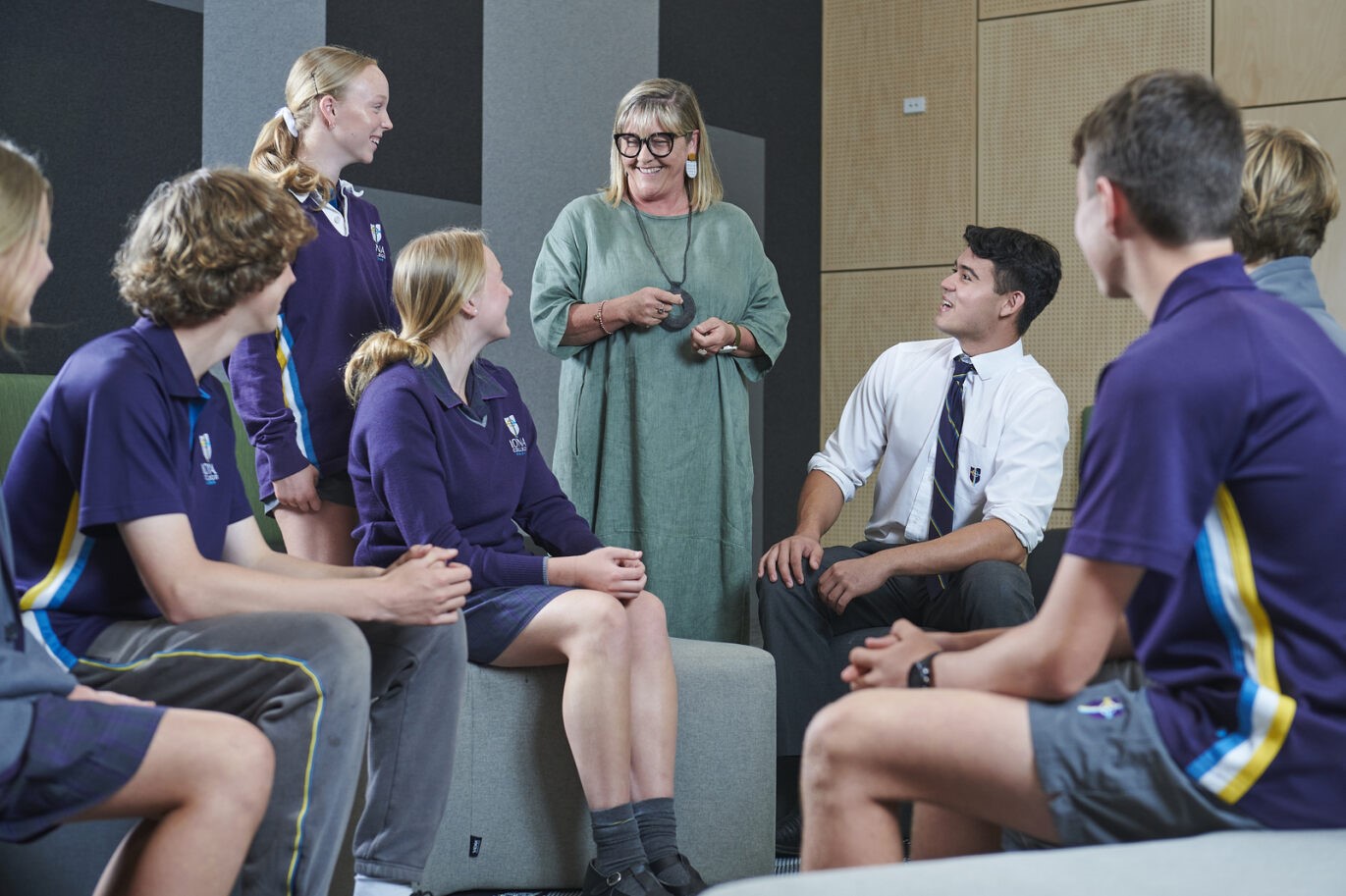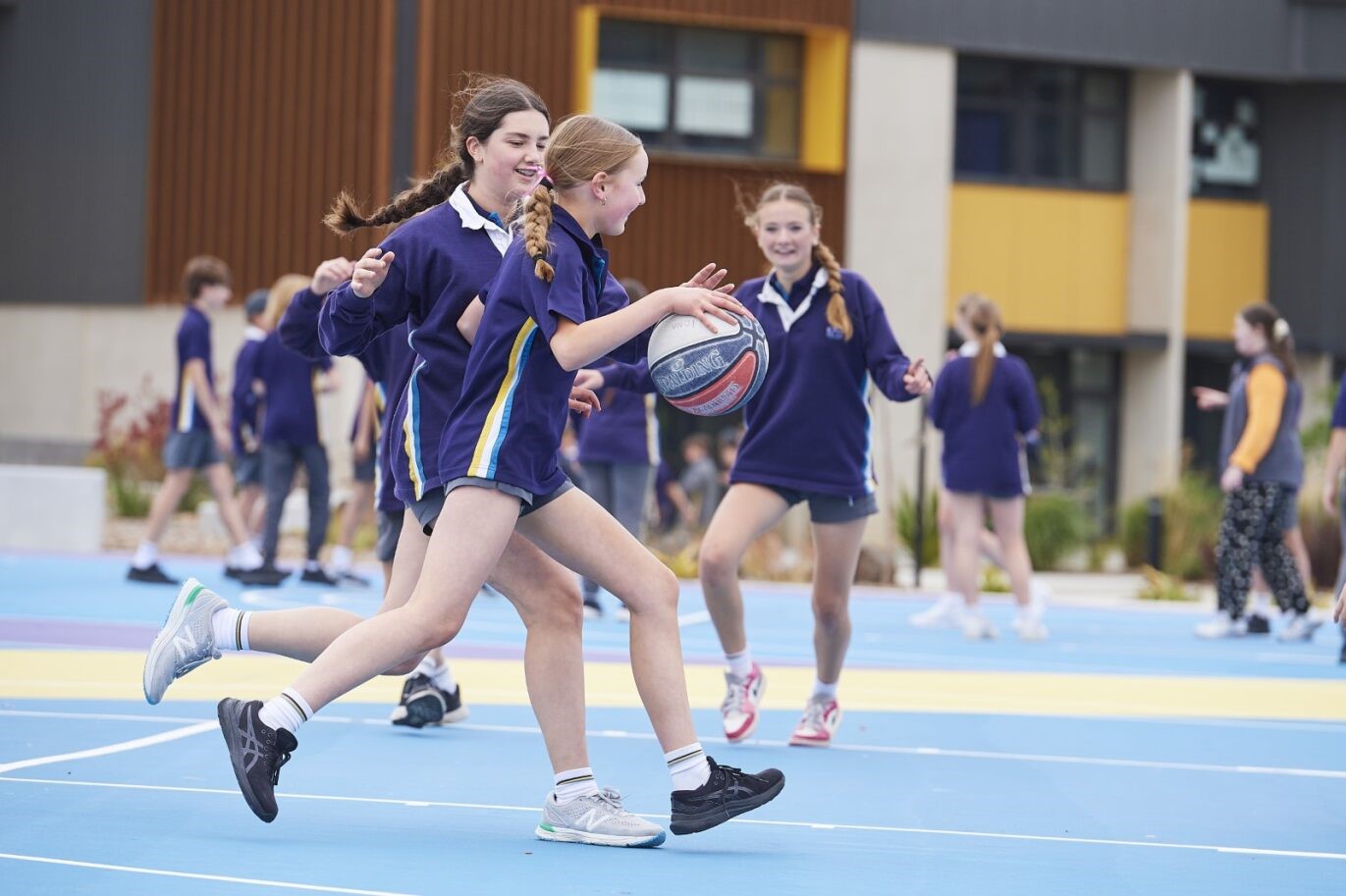Published 22 Apr 2024
Weekly check-in advancing student wellbeing – Iona College Geelong
Engaged with colleagues, school and the broader community
Kylie Power – Deputy Principal
Iona College Geelong
Schools and early childhood services across Victoria continue to provide quality learning experiences across all levels. The VIT’s Professional Practice team is privileged to see this work first-hand on visits to workplaces around the state. This is just one example showcasing the great work happening in a Victorian school.
Iona College Geelong, now in it’s fifth year of operation, was determined to embed strong wellbeing practices in the foundations of their community. From the outset, wellbeing has been one of the school’s top priorities for both learners and staff.
Thanks to an evidence-based approach and an application drawing real-time data from learners, the school has been able to identify trends, improve communication with families and better support vulnerable children. We spoke to Deputy Principal Kylie Power about the award-winning practices in place at Iona College.
Q: Can you provide some background to your approach in developing the initiative, including any research or established models or strategies that your approach is based upon?
I was appointed as a Deputy Principal at Iona College Geelong in 2021. Iona is a new Catholic Coeducational Secondary College that opened with Year 7s in 2020.
Working in partnership with Foundation Principal Mr Damian McKew and Deputy Principal Mel Gould, our ultimate goal was to create an environment and culture where students not only excelled academically but also developed the important social and emotional skills needed to navigate the world both now and in the future. Our school prides itself on being a college that puts relationships at the heart of what we do, so ensuring that a whole school approach to wellbeing and social and emotional learning (SEL) was part of the school improvement plan was essential for us. This approach to wellbeing is a long-term process that has required commitment from all members of our community. Recently, I was fortunate to be recognised among The Educator Australia’s Most influential educators for this work integrating wellbeing to improve learning for all students.
A whole school approach to wellbeing that encompasses learning is vital for wellbeing initiatives to be successful. I have always strived to embed this into the schools that I work with and know just how fundamental this is for long-term success.
Our wellbeing data is collected from all students weekly via the Linewize Pulse platform. A weekly 60 second check-in that asks students how they are feeling and is monitored in real time by the students community group teacher, wellbeing leaders and support staff. This allows students to reach out for help in a quick and efficient manner and normalises help-seeking behaviour. The check-in also asks students about their learning, their health, their relationships, their engagement, and other important predictors of illbeing or wellbeing. There is no doubt the pandemic also had an impact on the social emotional development of our students and initiatives are developed based on the data our students give us, not necessarily the trends or data that comes from statewide or nationwide sources. Each school is unique, and initiatives must be carefully selected based on what our students tell us and the data we have available.
One of our initiatives to highlight the link between wellbeing and learning is the creation of the subjects ‘Learning to learn’ and ‘Pathways to success’. These subjects have curriculum that reinforce our wellbeing approach and are adaptive and adjustable to the specific needs of a particular class or cohort. We consider the diverse learning styles and needs of students. The curriculum has been designed based on Positive Education evidence-based curriculum with a major focus on metacognition and self-regulation. Students are involved in thinking about their own thinking processes, whilst a passion project (a non-teacher directed task) is self-directed and allows for self-regulation and monitoring of their own behaviour, emotions, and cognitive processes.
Regular self-reflection and self-evaluation assist our students to evaluate their progress and know themselves as learners. Explicit teaching of mindsets, character strengths, grit and the importance of effort for successful learning are the foundation of these important subjects. Moving forward integrating this work into all subjects will be Iona’s focus and ultimately produce young people who are true lifelong learners that embody our school motto ‘learning to change the world’.
Q: What structural things are in place to ensure that the initiative has its best chance of success?
My background and previous experience in whole school wellbeing and learning diversity provided a great foundation to build this program from the ground up.
To avoid a siloed approach, we’ve embedded the following principles
- Leadership living and modelling wellbeing in our roles
Both Damian and myself prioritise wellbeing of staff as much as we do our students. Building a school from the ground up is hard work – looking after everyone’s wellbeing influences the school’s overall environment. Working closely with Meg Durham from the school of wellbeing podcast, our focus on staff wellbeing is something that Iona believes is a worthwhile investment. - Professional Development of staff – including non-teaching staff
Having a clear 5-year plan integrated into an Annual Action Plan (AAP) and School Improvement Plans (SIPs) is essential. Adopting evidence-based wellbeing programs and initiatives based on wellbeing science enables all staff to model SEL skills and wellbeing practices in their interactions with all students. Character strengths, mindsets, grit, flow, and emotional literacy are integrated into staff meetings, professional development and curriculums across a variety of subject areas. - Evidence-based SEL curriculum
Based on their unique student body, SEL curriculum focuses on career development, social emotional skills, trauma-informed practices, and includes positive education at all year levels. Taking the best of what is out there and adapting to suit the school’s unique needs (based on student data and student voice) is essential to ensure wellbeing is embedded into students’ lives across the college. - Parent and Community connection
Prioritising connection, especially for a new college engaging parents and external community agencies, has been vital. Tapping into wellbeing knowledge and evidence-based initiatives has allowed Iona to build its reputation in the community and this collaboration extends to involving parents in workshops and targeted seminars based on their needs. This has promoted a sense of connectedness and trust and has allowed a true partnership between wellbeing and learning to emerge. - Celebrate your practice
Reviewing and adapting the program based on student feedback and data is important and so to is sharing this with the community. Using the college social media and news platforms means the Iona community is aware of our work and helps everyone stay up to date with the latest wellbeing science and research and has allowed best practice to be embedded.
Q: What are the greatest benefits to staff development of this approach?
Our staff have a clear sense of direction and purpose and understand that wellbeing is everyone’s business.
The ongoing professional development of our team is having a meaningful impact on the delivery of a whole-school wellbeing approach. There is an immense benefit to our school’s culture and learning programs when we have all teachers feeling confident and empowered to deliver a wellbeing focused approach in their classrooms.

Deputy Principal Kylie Power with students at Iona College Geelong

Students at Iona College Geelong
Q: What have been the benefits to learner outcomes of this approach? Please provide some illustrative examples if appropriate.
Teaching SEL explicitly focusing on the personal and social capabilities has allowed staff to focus on clear outcomes for students and ensure that all learners across the school are flourishing. These are important skills that we want all students to develop and unless you explicitly teach and map these important learnings it is very easy to lose sight of the bigger picture.
If students are not doing well, their learning is going to be affected. In having a weekly dedicated opportunity for learners to self-reflect on their wellbeing, and seek-help if they need it, we can address issues that might be affecting learner engagement quickly and consciously.
Through investing in the social and emotional learning of our students, their academic performance and overall emotional wellbeing has been able to flourish as a result.
Q: What plans does your workplace have to take this approach forward?
Student voice and agency underpins the school’s wellbeing approach and we continue to revise and adapt our programs based on what student data tells us. As the school continue to grow, we are committed to prioritising an integrated approach to wellbeing and learning. Sam Wood leads the College in his role as Student Voice and Agency leader ensuring that student voice is embedded into our practice.
Moving forward, integrating this work into all subjects will be Iona’s focus and ultimately produce young people who are true lifelong learners ‘learning to change the world’ (Ionas motto). Additionally, as part of our whole-school strategic planning, we recently created a new position of leadership, Wellbeing for Learning, appointing Ashley Mills to the position. A true commitment to ensuring wellbeing is not separated from learning in our approach.
Q: Can you detail any references or citations applicable?
- Linewize Pulse – Linewize
- Institute of Positive Education – Geelong Grammar School
- Positive Education Guide – Positive Education Schools Association (PESA)
- Berry Street Education Model – Berry Street
- The school of Wellbeing with Meg Durham podcast – Open mind education
- The HAT Wellbeing program – HAT Wellbeing
Do you have an example of outstanding work in your school or early childhood service? We’d like to consider showcasing it the Excellence in Teaching section of our website. Send your example and contact details to vitcomms@vit.vic.edu.au.
